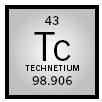Technetium

MELTING POINT:
2,157°C
BOILING POINT:
4,265°C
DENSITY:
11.5 g/cm
3
MOST COMMON IONS:
TcO
5
2−
,
TcO
3
−
,
TcO
4
2−
,
TcO
4
−
The discovery of technetium in 1937 by the Italian scientists Carlo Perrier and Emilio Segré was an important affirmation of the configuration of the Periodic Table. The table had predicted the existence of an element with 43 protons in its nucleus, but no such element had ever been found. (In fact, technetium does not occur naturally on Earth, as all of its known isotopes are radioactive and decay to other elements on a timescale that is relatively small when compared with the age of the earth.) Perrier and Segré were able to observe technetium from molybdenum that had been bombarded with deuterons. They named the element technetium, from the Greek word technetos, meaning artificial. Technetium is produced in relatively large quantities during nuclear fission , so there is currently an ample supply of the element from nuclear reactors and nuclear weapons production.
Technetium looks like most other metals , silver-gray in color, but it is usually produced as one of its oxides, pertechnetate (TcO 4 − ). Technetium has great chemical flexibility, and a wide variety of its compounds have been prepared, generally paralleling the known compounds of rhenium. Technetium's radioactive nature and varied chemistry have helped to make it the most important element that is used in nuclear medicine. For diagnostic purposes, a compound containing technetium is prepared and injected into a patient, and then a large camera, typically made up of several gamma ray detectors, is passed over the patient. The technetium compound will have localized in specific organs, providing valuable information about organ function or the presence of abnormalities. The radiation dose to the patient is low, and the diagnostic procedure is considered less risky than exploratory surgery. Every year, millions of medical diagnostic scans that employ technetium are performed.
SEE ALSO Nuclear Fission ; Rhenium .
Jeffrey C. Bryan
Bibliography
Cotton, F. Albert, and Wilkinson, Geoffrey (1988). Advanced Inorganic Chemistry, 5th edition. New York: Wiley.
Weast, Robert C., ed. (1988). CRC Handbook of Chemistry and Physics, 68th edition. Boca Raton, FL: CRC Press.
Comment about this article, ask questions, or add new information about this topic: